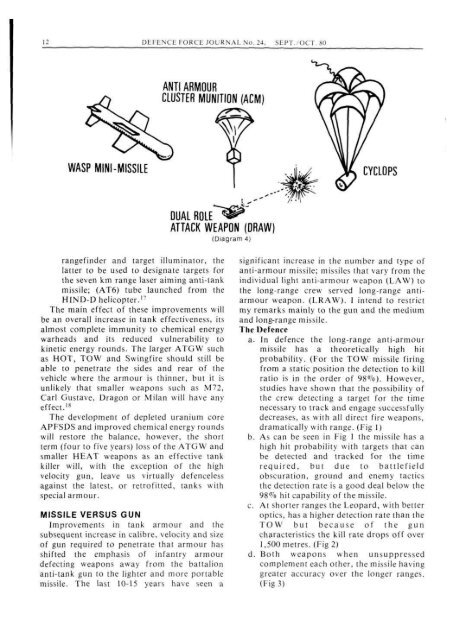ISSUE 24 : Sep/Oct - 1980 - Australian Defence Force Journal
ISSUE 24 : Sep/Oct - 1980 - Australian Defence Force Journal
ISSUE 24 : Sep/Oct - 1980 - Australian Defence Force Journal
- No tags were found...
Create successful ePaper yourself
Turn your PDF publications into a flip-book with our unique Google optimized e-Paper software.
DEFENCE FORCE JOURNAL No. <strong>24</strong>. SEPT./OCT. 80ANTI ARMOURCLUSTER MUNITION (ACM)WASPMINI-MISSILECYCLOPSL.DUAL ROLE **ATTACK WEAPON (DRAW)(Diagram 4)rangefinder and target illuminator, thelatter to be used to designate targets forthe seven km range laser aiming anti-tankmissile; (AT6) tube launched from theHIND-D helicopter."The main effect of these improvements willbe an overall increase in tank effectiveness, itsalmost complete immunity to chemical energywarheads and its reduced vulnerability tokinetic energy rounds. The larger ATGW suchas HOT, TOW and Swingfire should still beable to penetrate the sides and rear of thevehicle where the armour is thinner, but it isunlikely that smaller weapons such as M72,Carl Gustave, Dragon or Milan will have anyeffect. 18The development of depleted uranium coreAPFSDS and improved chemical energy roundswill restore the balance, however, the shortterm (four to five years) loss of the ATGW andsmaller HEAT weapons as an effective tankkiller will, with the exception of the highvelocity gun, leave us virtually defencelessagainst the latest, or retrofitted, tanks withspecial armour.MISSILE VERSUS GUNImprovements in tank armour and thesubsequent increase in calibre, velocity and sizeof gun required to penetrate that armour hasshifted the emphasis of infantry armourdefecting weapons away from the battalionanti-tank gun to the lighter and more portablemissile. The last 10-15 years have seen asignificant increase in the number and type ofanti-armour missile; missiles that vary from theindividual light anti-armour weapon (LAW) tothe long-range crew served long-range antiarmourweapon. (LRAW). 1 intend to restrictmy remarks mainly to the gun and the mediumand long-range missile.The <strong>Defence</strong>a. In defence the long-range anti-armourmissile has a theoretically high hitprobability. (For the TOW missile firingfrom a static position the detection to killratio is in the order of 98%). However,studies have shown that the possibility ofthe crew detecting a target for the timenecessary to track and engage successfullydecreases, as with all direct fire weapons,dramatically with range. (Fig 1)b. As can be seen in Fig 1 the missile has ahigh hit probability with targets that canbe detected and tracked for the timerequired, but due to battlefieldobscuration, ground and enemy tacticsthe detection rate is a good deal below the98% hit capability of the missile.c. At shorter ranges the Leopard, with betteroptics, has a higher detection rate than theTOW but because of the guncharacteristics the kill rate drops off over1,500 metres. (Fig 2)d. Both weapons when unsuppressedcomplement each other, the missile havinggreater accuracy over the longer ranges.(Fig 3)

















